The Olympic legacy
The legacy of the 2012 Olympics will be significant, they said. Everyone in the community is going to benefit, they said. They were not entirely wrong. However, booking yourself into a track cycling session at the Olympic Velodrome near Stratford in London is not as straightforward as say Herne Hill, but it’s well worth the effort.
Compared to the ‘turn up and ride’, ‘all are welcome’, ‘sling us a tenner’ approach at Herne Hill and other outdoor velodromes, organising a session at Lee Valley is a bit harder. It’s like the difference between buying a falafel sandwich and struggling to make your own suhsi. You’ll need to book in advance through the Velodrome’s website, and despite a drop in price post Covid, you’ll still need to ‘pony up’ a fair chunk of change.
Heads up, there’s an extra charge for helmet and bike hire. So, it’s a good idea to bring your own helmet and even track bike if you have one. More on that later…
So whenever my cycling club offers me a free session here, I jump at the opportunity to experience riding that silky smooth Siberian pine (this is the wood the track itself is made of).
In the end though, if you find track cycling is for you, then Herne Hill represents a great, affordable way to regularly train and learn race and track craft going forward.
The Olympic Velodrome: getting there
The first thing you notice when you arrive is that it looks remarkably like a massive Pringle crisp, which is why it’s known locally as ‘The Pringle’.
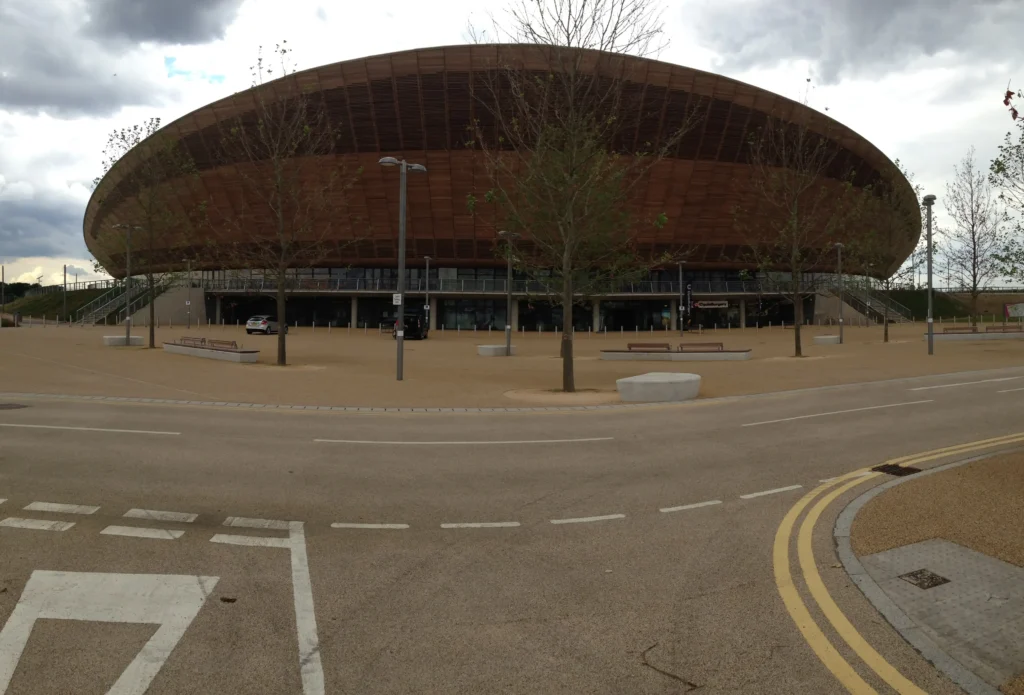
Access to the site is very car-centric. The Olympic Park has broad, sweeping roads with no cycle lanes, more suited to motor vehicles, than to bikes or pedestrians. A ‘could do better’ design result, if you ask me. Also, the track’s situated on the far fringe of the park and because the roads are so pushbike unfriendly, it’s a bit of a schlep to get to.
If you’ve ever been to a funfair and seen one of those ‘wall of death’ rides or been to one of those anti-gravity spinning things where you stick to the side of the wall as the floor sinks away from you, it’s that steep!
However, once safely in the car park at the base of the futuristic building under the impressive wooden-clad overhang, the path guides you towards the sweeping glass door entrance.
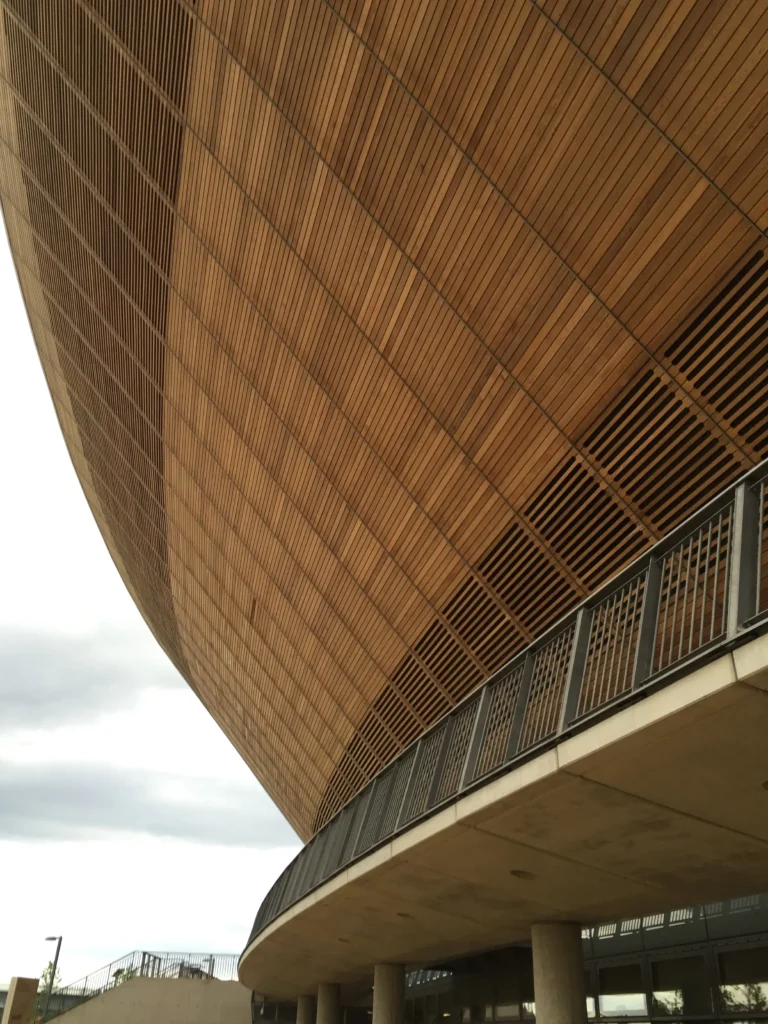
Inside, there’s an equally impressive reception. There are bike racks to the right of the reception desk where people who do come by bike can safely lock up their commuter.
There are very few sports where you’re able to train and compete where your heroes do, but cycling is one of those sports.
After you’ve registered and paid your dues, you make your way to track centre through another set of heavy doors. These lead to a majestic, wide concrete staircase down into the well of the building.
The facilities
You find yourself in a corridor with a labyrinth of rooms just below the floor of the spectator seating that flows around the oval-shaped track. Leading off this corridor there are changing rooms, other facilities, offices and fitness studios.
Head along this corridor a short distance and you’ll come across the first set of changing rooms where you can get into your cycling gear. Once changed, it’s off to the track centre.
To track centre
As you make your way down more imposing concrete steps, you get the sense that you are walking in the footsteps of giants. Not only did all the world’s best cyclists of that time walk these actual steps when it was first opened for the Olympics in 2012, but world-class events featuring world-class riders have continued to be held ever since. It feels almost gladiatorial! There are very few sports where you’re able to train and compete where your heroes do, but cycling is one of those sports.
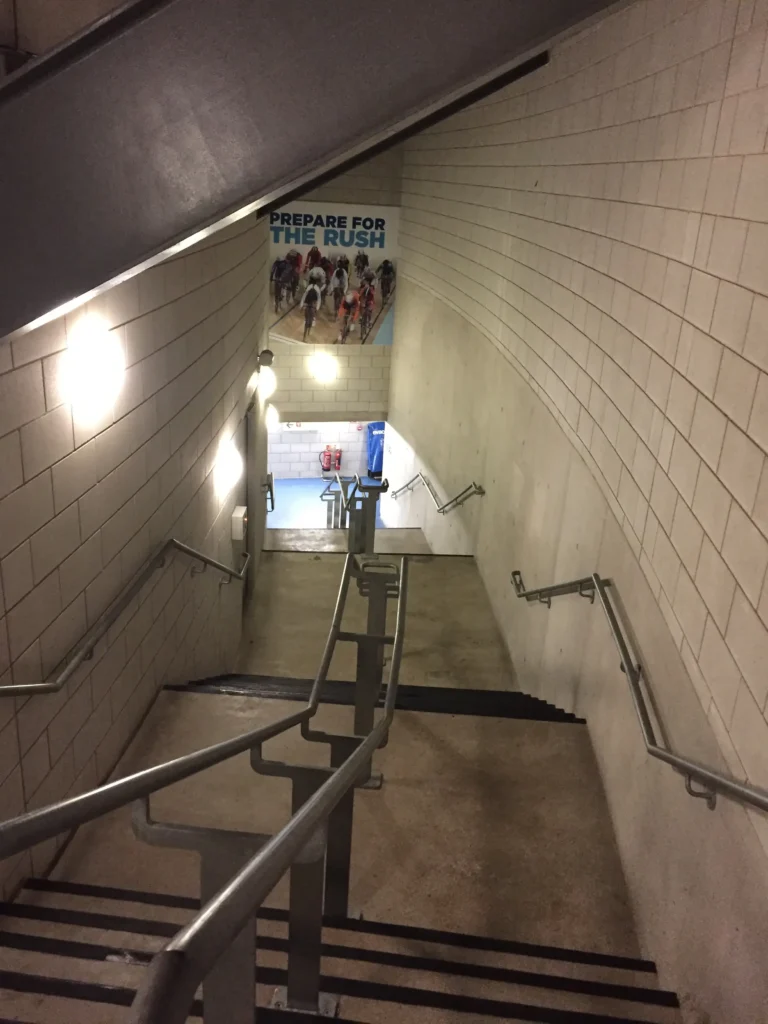
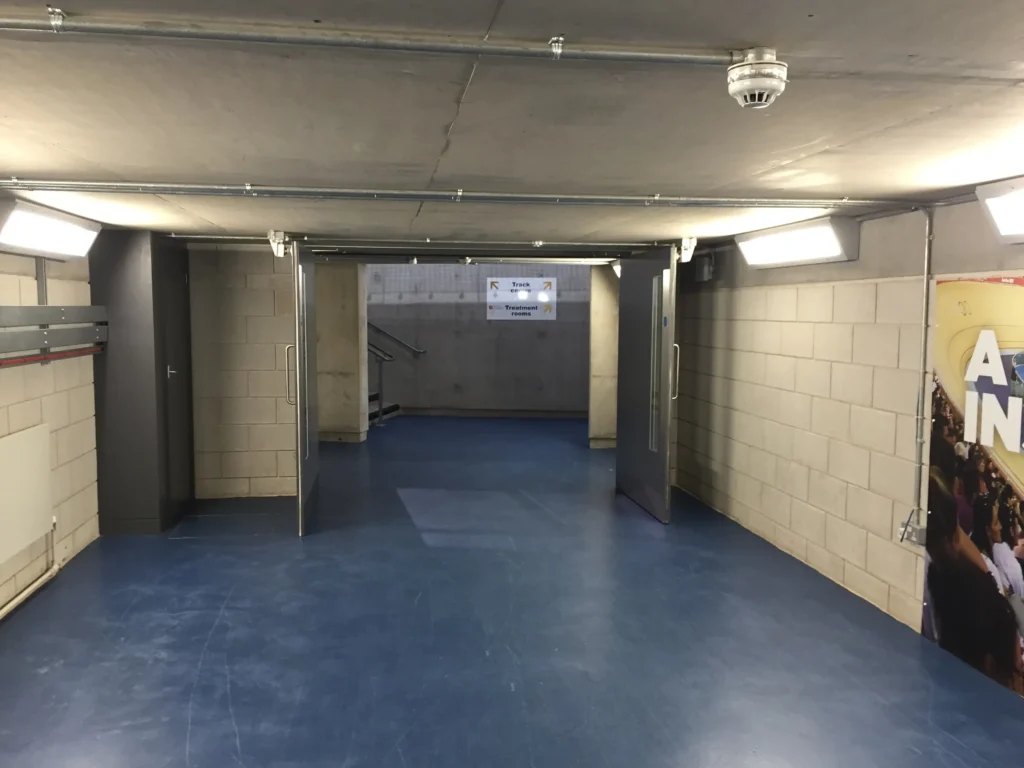
At the bottom of the steps and underneath the track itself, you emerge either by a ramp or some stairs into the centre of the Velodrome.
The air is eerily still.
It’s striking. This is no typical gym hall. It’s big; like football stadium big! It’s very much a sports arena. It’s high.

First impressions
The wooden track wraps its curves around you and towers above you. The banking is steep—so very steep. You almost have to look skyward to see the top. If you’ve ever been to a funfair and seen one of those ‘wall of death’ rides or been to one of those anti-gravity spinning things where you stick to the side of the wall as the floor sinks away from you, it’s that steep! Should there be a rider or two swooshing around, they look pretty small.
Track bikes are the most minimal of bicycles. They have no gears, and importantly… NO BRAKES!!
It’s not cold and not hot. The air is eerily still. A cyclist travels faster through this warm, still air. The track is surrounded by railings that define where the track finishes and the spectator seating begins. It’s a very unique place to be.
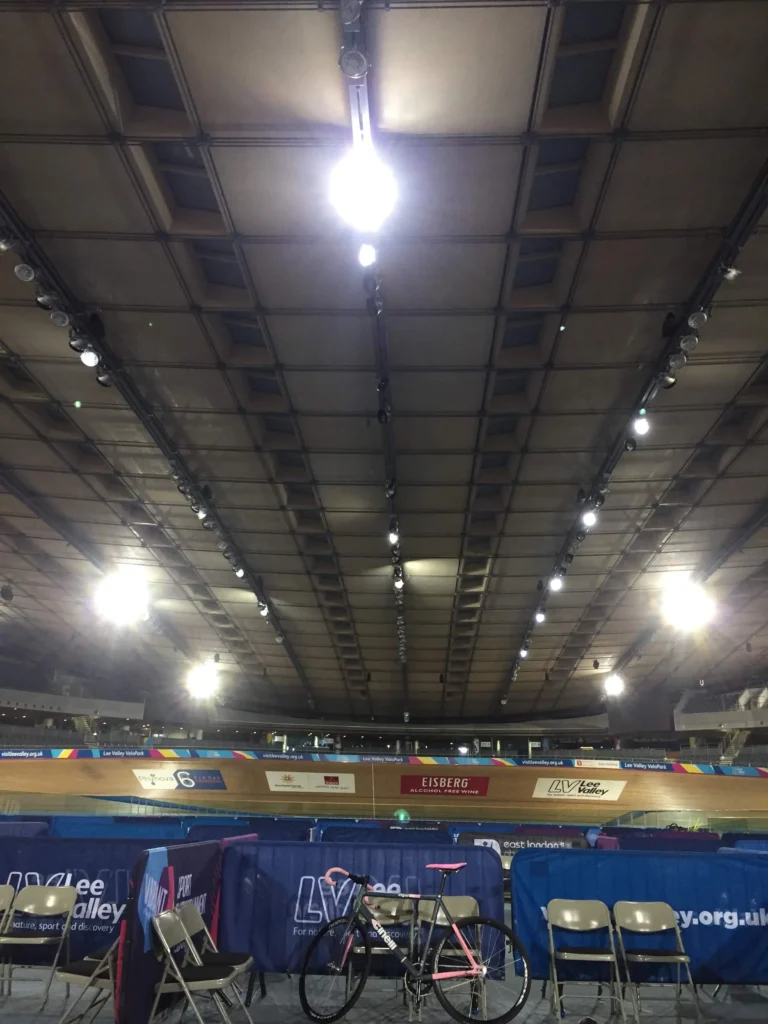
The track cycling ‘taster session’
It can be daunting, but you should try to relax. The staff and coaches are there to help, answer any queries, and support you as much as possible.
Unless there’s a major event on, the centre of the track can feel pretty empty. The first thing you’ll need is a bike. You’ll see a large rack with loads of hire bikes in several sizes. Go to the desk beside the rack, speak to an attendant, and show your payment receipt. They will then select the best one for you.
Getting saddled up
Track bikes are the most minimal of bicycles. They have no gears, and importantly… NO BRAKES!! Don’t freak out though, all the other bikes on the velodrome are the same. Nobody has brakes therefore nobody can suddenly stop in front of you. So, you don’t need them! If you were the only person riding around with brakes, people would crash into the back of you whenever you used them. Counterintuitively, you are safer without them!!
The banking is steep. If you have cranks longer than 165mm, you might find your pedal will strike the floor.
The fixed gear itself gives you a way of slowing down by resisting the turning of the pedals with your legs. It’s very important to remember that the pedals on a track bike never stop turning! They continue to turn, come what may – even when you don’t expect them to. This can catch you out and give you quite a jolt. Usually this only happens the once, as the shock is enough to make you remember.
Safety first
Your instructor will not allow you to ride without a helmet, gloves, and ideally two layers on top, preferably long sleeve jerseys. This adds protection from any potential ‘road rash’ should you come off and slide on the boards… Of course, this isn’t going to happen, but preparation for an unlikely event is good insurance. Your coach will also walk you through some bike specific safety checks, which are worth paying attention to.
I have a fixie bike; can I use it?
Although fixies look like track bikes, it’s not always a great idea to try to take yours track riding. There are a few things that you need to be aware of…
The banking is steep. If you have cranks longer than 165mm, you might find your pedal will strike the floor. Also city fixies don’t usually have enough bottom bracket clearance making them too low to the ground. This could see you comically poll vaulting over your pedal as it hits the track. The result will be a painful body-meets-floorboard interaction. Fortunately, that’s not going to happen as your city bike will not pass the safety check.
Your tyres also need to be track specific. They have to have enough grip to keep you upright on the steep angles. Other things, like making sure handlebars have bar-end plugs, are super important. However, you can always ask to ride your own bike. Be aware, you may be allowed to use it.
And you’re off
There’s something about the feeling of gliding around the super smooth wooden track surface on rock hard tyres pumped up to a bursting 160 lbs per square inch that’s hard to describe. There’s the sensation of the still air waft by as you push through it. The tick, tick, tick, tick of that 1/4 inch fixed wheel chain meshing perfectly with the sprockets as you roll along. No bumps, pot holes, road vibrations, or imperfections… All this makes the perfectionist inside me very happy, and I find I really connect.
Knowing how to use the banking wins races…
You get a strange, calm, almost effortless sense of forward motion. Not that it’s effortless. Far from it. Pushing those pedals comes at a cost, which you pay for with burning sensations in lungs, legs, and heart. It’s alarming how tough riding the track is, particularly the first time. Of course, your excitement and apprehension mask those feelings initially.
After you manage to get on the bike and push off from the hand rail, you’ll be made to roll slowly around on the ‘Cote d’ Azure’. This is the flat bit painted blue at the bottom of the track proper. Your instructor will then encourage you to ride a little quicker and move up onto the ‘white line’ on the track itself. Then higher. Then higher still. Until you’re eventually riding around the very top. This takes nerve and quite a bit of effort. You also need to maintain some speed to get enough centrifugal force going to stick to the track and not slide down.
Nobody told me track cycling involves climbing!
The track isn’t flat!! You’ve got quite a hill to get up, as the banking sweeps from the virtually flat ‘straight’ section up to the rafters at the top where it swoops around the apex of the oval. You have to push really hard to maintain your speed.
Looking down is like looking out of a third-story window. You’re a long way above ground. And every time you go around the ‘corners’ at each end, you have to climb that elevation, and we all know how hard climbing can be.
Many of these skills make you a better road cyclist.
However, the descent makes it all worth it. Dropping down from the top of the banking onto the innermost white line gives you a massive burst in acceleration. Using this to your advantage is a large part of ‘track craft’. You may have seen sprinters drop from the top to the bottom of the track when battling it out. Knowing how to use the banking wins races…
Nobody told me there would be traffic
A velodrome is race track. So, you’ll need to learn how to ride at very close proximity to others. Some bigger races can have tens of riders on the track with you all going at different speeds. It can be very intimate.
So, your coach will take you through the art of observation and teach you the essential skill of looking over your right shoulder if you decide to move up and off your line. He or she will give you practice drills where you keep inches behind the rider in front. You’ll learn how to communicate, how to overtake, how to signal you intentions and how to decelerate and safely come down off the track.
There’s a lot teamwork involved
You also learn how to work together with other riders and take advantage of drafting techniques like holding two lines of riders, one moving slightly slower than the other, and how to change places at the front to share the workload. This is known as ‘Rotating’ or ‘Through and Off’. Your instructor will make you ride slowly, teach you how to keep even gaps, how to ride stacked alongside each other, and give you all sorts of insanely challenging drills. Many of these skills make you a better road cyclist.
…And you’re off!
After about an hour into your track cycling ‘taster session’, finally your coach will invite you to race against the other people there. You’ll probably start with a scratch race. This is the classic ‘first over the line is the winner’ race we all know and love. If there’s time you may progress to more sophisticated races. The coaches might split you into teams. One team on one side of the track and the other team on the opposite side. Your team then tries to catch the other. Road and and track cycling can be very different.
Very few will regret having had the opportunity to try this unique cycling discipline.
It doesn’t matter how hard you’ve trained, nothing can prepare you for the that sensation of your lungs being on fire when track cycling. As for your legs… the burning you feel will be something you’ve never felt before!
Then, suddenly, you’re track cycling is done
Then you’re done… in more ways than one. You hand back your bike and head back to the changing area to prepare yourself for the journey home.
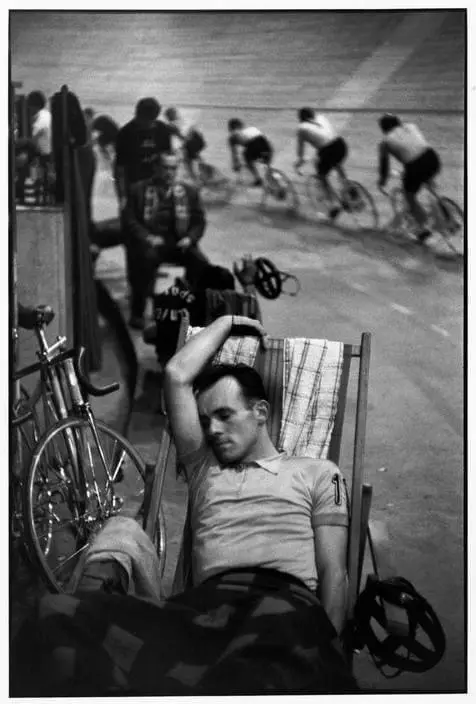
Track cycling is a pretty ‘big’ experience. If, like me, you connect with it, you’ll be gagging to get back out there as soon as possible. Others may feel less enthusiastic about the idea of revisiting the boards. Very few will regret having had the opportunity to try this unique cycling discipline. One likely takeaway is a large dose of DOMS the next day. Rest and recover. You’ll need it!
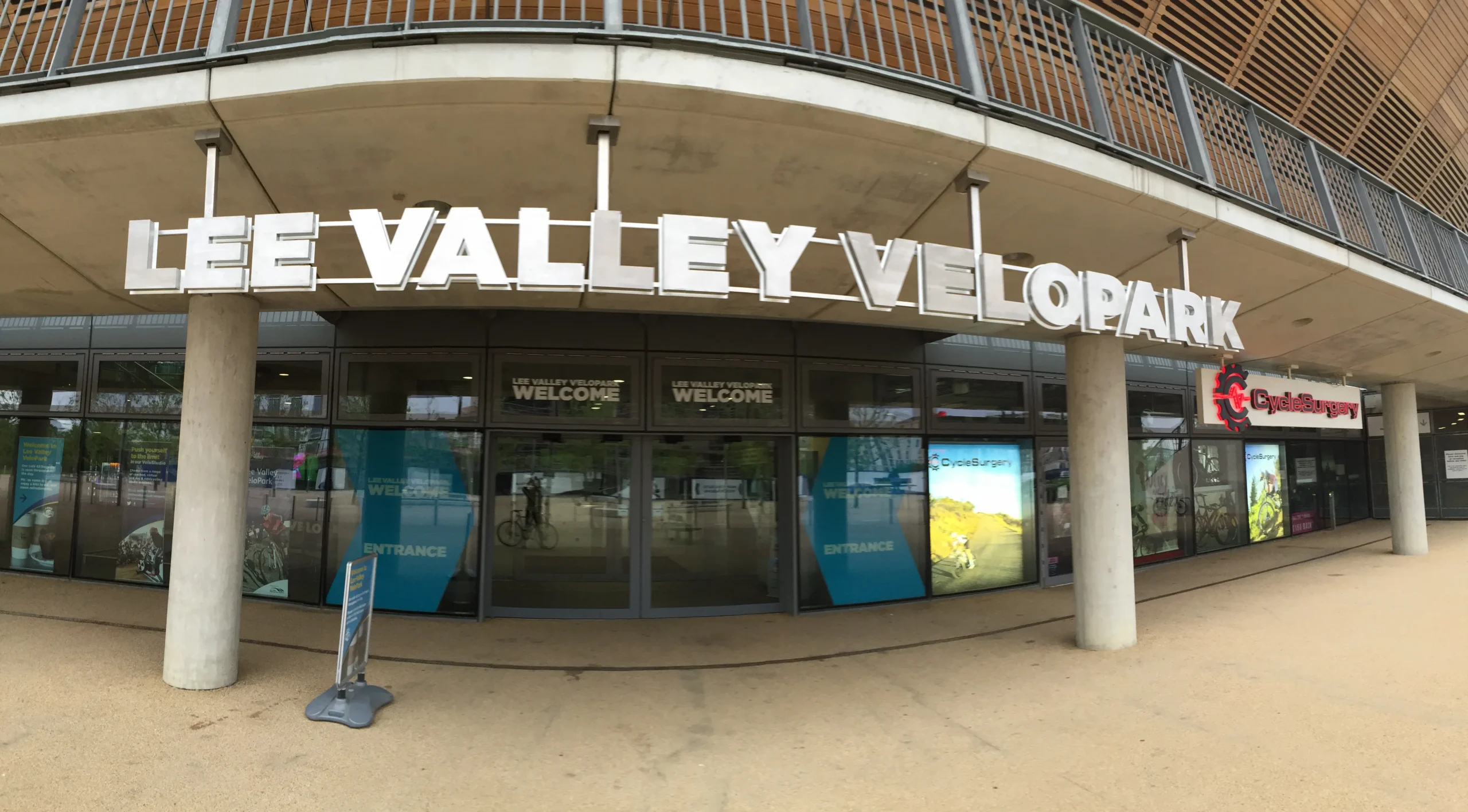
Leave a Reply